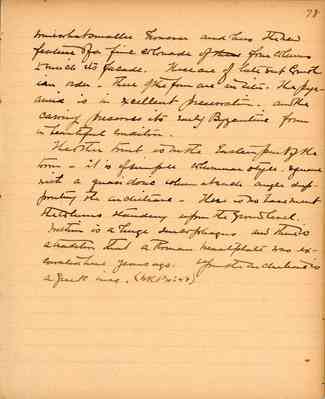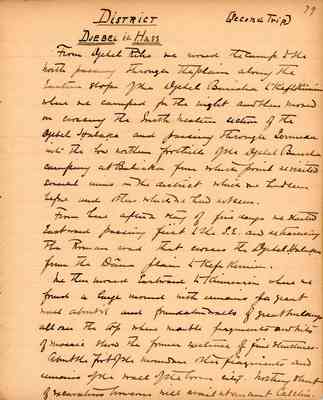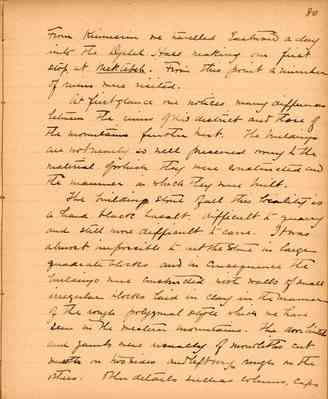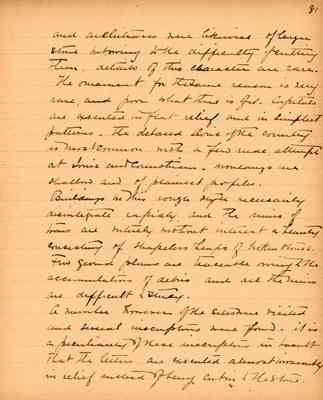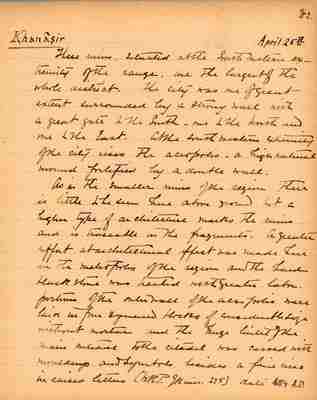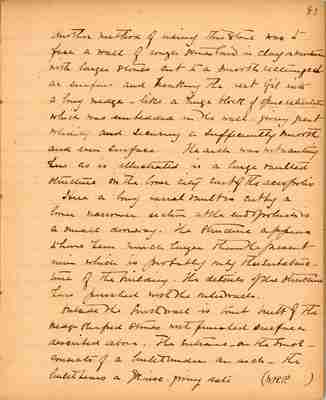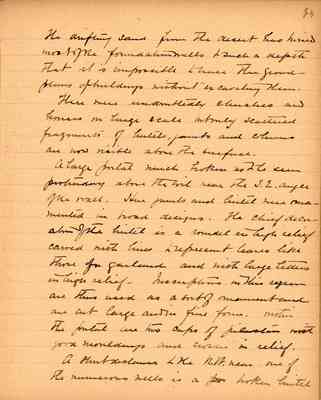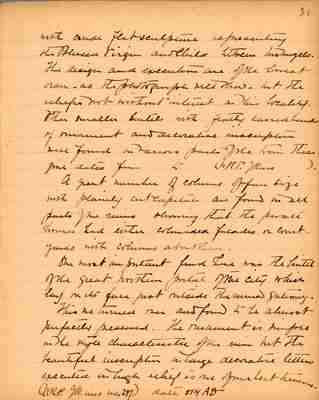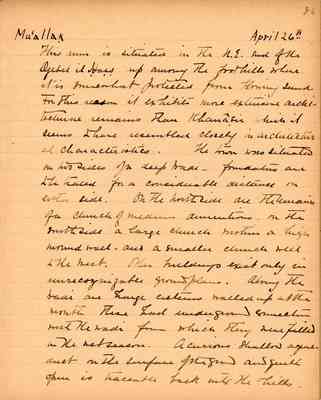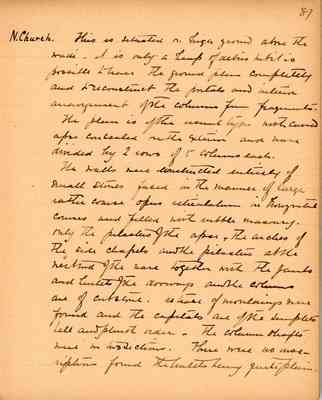Pages That Need Review
Butler Diary: Northern and Central Syria IV, 1900
BSY_FB_16-78
78
somewhat smaller however and has the new feature of a fine colonnade of four columns to match its façade. These are of late but Corinthian order. Three of the four are in situ. The pyramid is in excellent preservation, and the carving preserves its early Byzantine form in beautiful condition.
The other tomb is in the eastern part of the town. It is of simple columnar style - square with a quasi Doric column at each angle supporting the architrave. There is no basement the columns standing upon the ground level. Within is a huge sarcophagus and there is a tradition that a Roman breastplate was excavated here years ago. Upon the architrave is a Greek insc. (WKP no 248)
BSY_FB_16-79
79 District (Second Trip) Djebel il Ḥâss
From Djebel Rîhā we moved the camp to the north passing through the plain along the eastern slope of the Djebel Bārîsha to Kiftîn where we camped for the night and then moved in crossing the south western section of the Djebel Ḥaluḳa and passing through Sermedā into the low northern foothills of the Djebel Bārîsha camping at Bābisḳa from which point we visited several ruins in the district which we had seen before and others which we had not seen.
From here after a stay of five days we started Eastward passing first to the S.E. and retracing the Roman road that crosses the Djebel Ḥaluḳa from the Dânā plain to Kefr Kermîn. We then turned eastward to Kinnisrin where we found a large mound with remains of a great wall about it and foundation walls of great buildings all over the top where marble fragments and bits of mosaic show the former existence of fine structures.
About the foot of the mound were other fragments and remains of the wall of the lower city. History short of excavations however will avail at ancient Colchis.
BSY_FB_16-80
80
From Kinnisrin we traveled eastward a day into the Djebel Ḥâss making our first stop at Mektebeh. From this point a number of ruins were visited.
At first glance, one notices many differences between the ruins of this district and those of the mountains further west. The buildings are not nearly so well preserved owing to the material of which they were constructed and the manner in which they were built.
The building stone of all this locality is a hard black basalt, difficult to quarry and still more difficult to carve. It was almost impossible to cut the stone in large quadratic blocks and in consequence the buildings were constructed with walls of small irregular blocks laid in clay in the manner of the rough polygonal style which we have seen in the western mountains. The door lintels and jambs were usually of monoliths cut smooth on two sides and left very rough on the others. Other details such as columns, caps
BSY_FB_16-81
81
and architraves were likewise of larger stone but, owing to the difficulty of cutting them, details of this character are rare.
The ornament for the same reason is very rare, and poor what there is of it. Capitals are executed in flat relief and in simplest patterns. The debased Doric of the country is most common with a few rude attempts at Ionic and Corinthian. Mouldings are shallow and of plainest profiles.
Buildings in this rough style necessarily disintegrate rapidly and the ruins of towns are entirely without interest or beauty consisting of shapeless heaps of broken stones. Few ground plans are traceable owing to the accumulations of debris and all the ruins are difficult to study.
A number however of the sites we visited and several inscriptions were found. It is a pecularity of these inscriptions in basalt that the letters are executed almost invariably in relief instead of being cut in to the stone.
BSY_FB_16-82
82
These ruins, situated at the southwestern extremity of the range, are the largest of the whole district. The city was one of great extent surrounded by a strong wall with a great gate to the South - one to the North and one to the East. At the southwestern extremity of the city rises the acropolis - a high natural mound fortified by a double wall.
As in the smaller ruins of the region there is little to be seen here above ground but a higher type of architecture marks the ruins and is traceable in the fragments. A greater effort at architectural effect was made here in the metropolis of the region and the hard black stone was heated with greater labor. Portions of the outer wall of the acropolis were laid in fine squared blocks of considerable size without mortar and the huge lintel of the main entrance to the citadel was carved with mouldings and symbols besides a fine insc in raised letters (W.R.P. GK insc 298) date 384 A.D.?
BSY_FB_16-83
83
Another method of using the stone was to face a wall of rough stones laid in clay or mortar with larger stones cut to a smooth rectangular surface and breaking the rest of it into a long wedge - like a huge block of opus reliculatum which was embedded in the wall, giving great solidity and securing a sufficiently smooth and even surface. The arch was not wanting here as is illustrated in a large vaulted structure on the lower city east of the acropolis.
Here a long barrel vault is cut by a lower narrower section at the end of which is a small doorway. The structure appears to have been much larger than the present ruin which is probably only the substructure of the building. The details of the structure have perished with the outer walls.
Outside the south wall is tomb built of the wedge shaped stones with finished surfaces described above. The entrance - on the south - consists of a lintel under an arch. The lintel bears a GK. insc. giving date (blank) (W.R.P. blank)
BSY_FB_16-84
84
The drifting sand from the desert has buried most of the foundation walls to such a depth that it is impossible to trace the ground - plans of buildings without excavating them.
There were undoubtedly churches and houses on large scale but only scattered fragments of lintels, jambs, and columns are now visible above the surface.
A large portal much broken is to be seen protruding above the soil near the S.E. angle of the wall. Here jambs and lintel were much ornamented in broad designs. The chief decoration of the lintel is a roundel in high relief carved with lines to represent leaves like those of a garland and with large letters in high relief. Inscriptions in this region are thus used as a sort of ornament and are cut large and in fine form. Within the portal are two caps of pilasters with good mouldings and crosses in relief.
A short distance to the N.W. near one of the numerous wells is a broken lintel
BSY_FB_16-85
85
with crude flat sculpture representing the Blessed Virgin and child between two angels. The design and execution are of the lowest order - as the photograph will show - but the reliefs not without interest at this locality Other smaller lintels with flatly carved bands of ornament and decorative inscription were found in various parts of the town. These give dates from (blank) to (blank) (W.R.P. GK insc (blank) )
A great number of columns of fair size with plainly cut capitals are found in all parts of the ruins showing that the private homes had either colonnaded façade or courtyards with columns about them.
Our most important find here was the lintel of the great northern portal of the city which lay on its face just outside the ruined gateway. This we turned over and found to be almost perfectly preserved. The ornament is simple in the style characteristic of the ruin but the beautiful inscription in large decorative letters executed in high relief is one of our best treasures. (W.R.P. GK insc no. 297) date 514 A.D.
BSY_FB_16-86
86
This ruin is situated in the N. E. end of the Djebel il Ḥâss up among the foothills where it is somewhat protected from flowing sand. For this reason it exhibits more extensive architectural remains than Khanâṣir which it seems to have resembled closely in architectural characteristics. The town was situated on two sides of a deep wadi - foundations are to be traced for a considerble distance on either side. On the north side are the remains of a church of medium dimensions, on the south side a large church within a high mound wall - and a smaller church well to the west. Other buildings exist only in unrecognizable ground plans. Along the wadi are huge cisterns walled up at the mouth. These had underground connection with the wadi from which they were filled in the wet season. A curious shallow aquaduct on the surface of the ground and quite open is traceable back into the hills.
BSY_FB_16-87
87
N. Church. This is situated on high ground above the wadi. It is only a heap of debris but it is possible to trace the ground plan completely and to reconstruct the portals and interior arrangement of the columns from fragments.
The plan is of the usual type with curved apse consealed on the exterior and nave divided by 2 rows of 5 columns each.
The walls were constructed entirely of small stones faced in the manner of large rather coarse opus reticulatum in horizontal courses and filled with rubble masonry. Only the pilasters of the apse, the arches of the side chapels and the pilasters at the west end of the nave together with the jambs and lintels of the doorways and the columns are of cut stone. No trace of mouldings were found and the capitals are of the simplest bell and plinth order. The column shafts were in two sections. There were no inscriptions found the lintels being quite plain.
